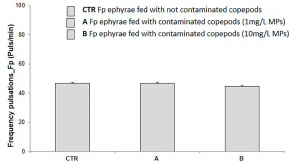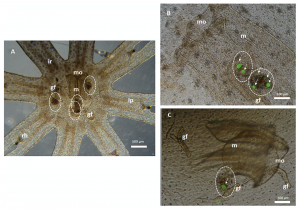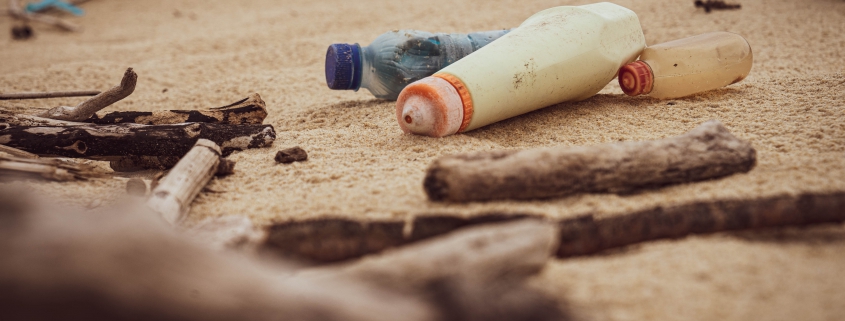Trophic transfer of microplastics from copepods to jellyfish in the marine environment
By Meagan Ando, SRC intern
Our oceans face great threats in this day and age. The list is quite expansive, but one such threat is microplastics. Microplastics are tiny bits of plastic, usually around the size of a sesame seed or smaller, that originate from everyday items such as water bottles or straws that find their way into the ocean (Image 1). Because of their size proximity to plankton, many marine organisms ingest these microplastics unknowingly, which can easily accumulate and be passed through trophic levels from zooplankton to fish and to other larger marine animals (Cole et al., 2013; Farrell and Nelson, 2013). Trophic levels are sequential stages in a food chain that comprises primary producers and subsequent primary, secondary, and sometimes tertiary consumers. Each predator/prey interaction involves a fraction of the amount of energy produced/consumed on the previous trophic level, making it possible for the exchange of these microplastics from level to level. This can be quite alarming, especially if these microplastics end up in the fish you eat for dinner in your home. That’s why the study of microplastic transfer between trophic levels is necessary. Although there was some information known regarding this topic, Costa et al. (2020) set out to answer more questions and fill the gap of knowledge regarding the microplastic transfer among zooplankton. This information about zooplankton was vital due to the fact that they are an important link between the primary producing phytoplankton (Turner, 2004), that use the process of photosynthesis to create energy, and the higher trophic levels (Costa et al., 2020).
In order to simulate a trophic level transfer system, the group created a simple two-level trophic cascade using the nauplii zooplankton species of the T. fulvus copepod as the prey and the ephyrae stage of the Aurelia species of jellyfish as predator (Costa et al., 2020). We know these species for being easy to study because of their large abundance, ease of culturing methods, and their role as excellent models in the evaluation of microplastic contamination. In short, they exposed the zooplankton nauplii to polyethylene microplastics for 6 hours and then offered to the ephyrae jellyfish for 24 hours in order to simulate the consumption of prey in the wild. The amount of consumed microplastics in the zooplankton were examined and verified using fluorescent microscopes to confirm that the nauplii were contaminated and that there was something for the jellyfish to be polluted with. In order to test the negative side effects of the microplastic contamination in the jellyfish, they evaluated both immobility and pulsation frequency in hopes of shedding some light on what ecotoxicological effects these tiny bits of plastics could have on a predator in a short time. Such results were determined using a recording system along with a video graphic analyzer. Immobility percentages, including those jellyfish that were completely motionless, were recorded, along with the pulsation frequency that was calculated using a recording of pulsations in a time frame of 1 minute (Costa et al., 2020).
Overall, the results found that the jellyfish had in fact ingested microplastics, confirming this physical trophic transfer (Image 2). Quite interestingly, there were not any significant ecological responses because of the influx of microplastics in the jellyfish population; immobility percentages were not statistically significant, and pulsation frequencies were only slightly decreased (Figure 1). To conclude, this group of researchers found that the trophic transfer of microplastics is clear through the indirect ingestion by predators and is significant in the ocean because of the ability of these jellyfish to carry heavy metals in their gelatinous tissues. Also, they agreed that a longer exposure time frame (over 24 hours) could lead to more visible, measurable ecotoxicological effects (Costa et al., 2020). This information is vital in protecting the health and well-being of not only the oceans and the organisms that inhabit it but also our very own family and friends. We can all help take steps in the reduction of microplastics in the environment by reducing our plastic usage (by using reusable items such as water bottles and bags) and recycling those items in which we use.

Figure 1: Graphic visual showing the pulsation frequencies between uncontaminated jellyfish and jellyfish containing the contaminated copepods (Costa et al., 2020).

Image 1: Example of everyday plastics found on a beach (Tim Hüfner).

Image 2: Set of images showing the trophic transfer after 24 hours. Image A shows the control jellyfish, completely free of contamination. Images B,C show copepod clusters within the jellyfish with white arrows pointing to the polyethylene microplastics (Costa et al., 2020).
Works cited
Cole, M., Lindeque, P., Fileman, E., Halsband, C., Goodhead, R., Moger, J., et al. (2013). Microplastic ingestion by zooplankton. Environ. Sci. Technol. 47, 6646–6655.
Costa, E., et al. (2020). Trophic transfer of microplastics from copepods to jellyfish in the marine environment. Frontiers in Environmental Science. Vol. 8.
Farrell, P., and Nelson, K. (2013). Trophic level transfer of microplastic: Mytilus edulis (L.) to Carcinus maenas (L.). Environ. Pollut. 177, 1–3.
Tim Hüfner via Unsplash.
Turner, J. T. (2004). The importance of small planktonic copepods and their roles in pelagic marine food webs. Zool. Stud. 43, 255–266.



